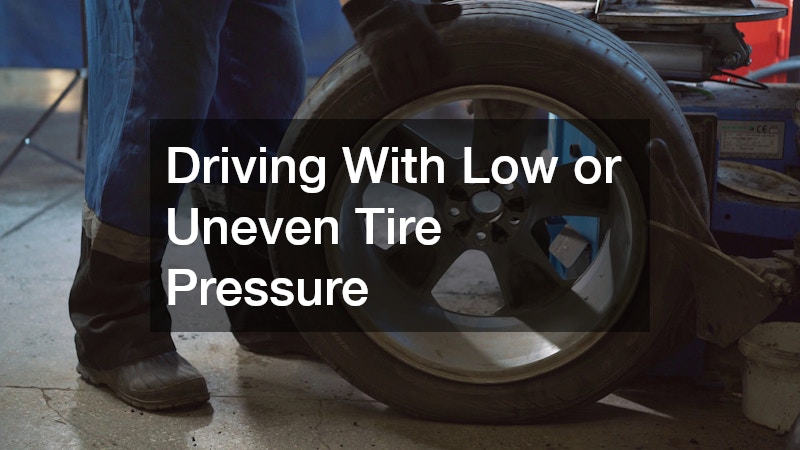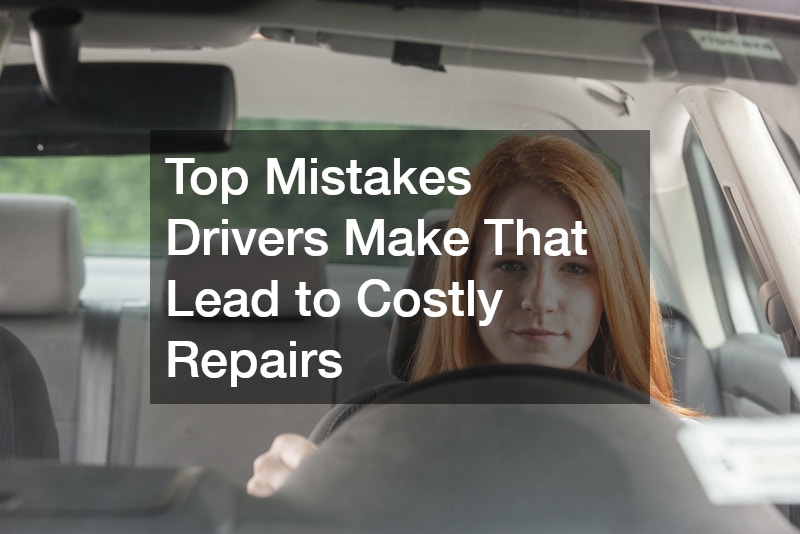- Ignoring early warning signs can lead to severe mechanical failures.
- Routine maintenance—especially oil changes and fluid checks—saves money long-term.
- Driving habits play a major role in wear and tear.
- Being proactive with inspections prevents emergencies.
- Following manufacturer maintenance schedules is essential.
- Minor issues like low tire pressure or old brake pads can escalate quickly.
- Seeking help from an experienced car repair shop with comprehensive services ensures accurate diagnosis and reliable repairs.

Cars are among the most expensive assets most people own, and keeping them in good shape is key to avoiding high repair bills. Unfortunately, many drivers unknowingly make small mistakes that can cause major mechanical problems over time. These oversights might seem minor at first, but they can lead to breakdowns, safety risks, and repairs that cost hundreds—or even thousands—of dollars.
In this guide, we’ll walk through the most common driver mistakes that often result in costly auto repairs. More importantly, we’ll explain why these habits are harmful and what you can do to avoid them. Whether you’re a seasoned car owner or a new driver, understanding these issues can help you extend your vehicle’s life and keep more money in your pocket.
1. Ignoring Dashboard Warning Lights
Dashboard warning lights are your car’s way of alerting you to problems before they get worse. Yet many drivers ignore these indicators, thinking they’ll go away or aren’t urgent.
What They Mean
- Check Engine Light: Indicates various issues, from a loose gas cap to a failing catalytic converter.
- Oil Pressure Light: Signals low oil pressure—this can destroy an engine if not addressed.
- Battery Light: Points to problems in the charging system (battery or alternator).
- ABS or Brake Light: Suggests a fault in the braking system.
Why Ignoring Them Is Dangerous
Ignoring warning lights can lead to:
- Engine failure
- Brake system malfunction
- Overheating and damage to internal components
- Poor fuel efficiency and higher emissions
Tip: Get your car checked as soon as a light appears. A minor sensor issue today could be a costly repair tomorrow.
2. Skipping Routine Oil Changes
Oil changes are one of the most basic maintenance tasks—and one of the most important.
Why Oil Is Essential
Engine oil lubricates moving parts, reduces heat, and removes impurities. Over time, oil breaks down and becomes less effective.
What Happens When You Skip It
- Increased engine wear
- Sludge buildup
- Overheating and seized engine components
- Reduced fuel efficiency
How Often Should You Change It?
- Check your owner’s manual—many modern cars need oil changes every 5,000 to 7,500 miles.
- Older cars or those using conventional oil may need changes more frequently.
3. Driving With Low or Uneven Tire Pressure

Tire pressure may not seem like a big deal, but it plays a crucial role in your vehicle’s safety and performance.
Why It Matters
- Improper tire pressure leads to poor handling, increased tire wear, and reduced fuel economy.
- Low pressure causes tires to overheat, which can lead to blowouts.
Consequences
- Uneven tire wear means more frequent replacements.
- Stress on the suspension system and steering alignment.
- Increased risk of hydroplaning in wet conditions.
Tip: Check your tire pressure monthly. Use a digital tire gauge and refer to the pressure listed in your car’s door frame.
4. Delaying Brake Repairs
Brakes are your first line of defense on the road. Postponing repairs can lead to dangerous situations.
Warning Signs to Watch For
- Squealing or grinding sounds
- Vibrations or soft brake pedal
- Longer stopping distance
- Brake warning light
What Delays Can Lead To
- Worn-out pads damaging rotors (costlier to replace)
- Brake fluid leaks leading to complete brake failure
- Damage to calipers or ABS sensors
Braking systems are complex. Even if you’re unsure of a noise or vibration, it’s best to have your brakes checked early.
5. Using the Wrong Fluids or Neglecting Fluid Levels
Fluids do more than just “run” your car—they’re essential to cooling, lubrication, and safe operation.
Common Fluids That Need Attention
- Engine Oil: Reduces friction and heat
- Coolant/Antifreeze: Keeps the engine from overheating
- Brake Fluid: Enables hydraulic brake pressure
- Transmission Fluid: Allows smooth gear shifts
- Power Steering Fluid: Ensures easy turning
Risks of Ignoring or Using the Wrong Fluid
- Engine overheating
- Brake system failure
- Transmission slipping or total failure
- Corrosion inside critical components
Tip: Use only manufacturer-recommended fluids. Mixing or substituting fluids may cause long-term damage.
6. Riding the Brakes or Accelerating Aggressively
Your driving habits greatly affect your car’s wear and tear.
What These Habits Do
- Riding the Brakes: Overheats brake pads and reduces their lifespan.
- Hard Acceleration: Wears out your engine, transmission, and tires faster.
- Sudden Stops: Damages brake components and puts extra pressure on suspension.
The Long-Term Impact
- Frequent brake replacements
- Lower fuel efficiency
- Strain on drivetrain and transmission
Drive Smart: Coast when you can, use gentle braking, and accelerate smoothly to extend your car’s life.
7. Ignoring Strange Noises, Vibrations, or Smells
One of the most common (and costly) mistakes drivers make is ignoring new or unusual symptoms coming from their vehicle. Strange sounds, vibrations, or odors may seem minor at first—especially if the car is still running normally—but they often signal underlying issues that are about to get worse. Many drivers brush them off, hoping they’ll go away. Unfortunately, waiting too long can turn a minor fix into a major (and expensive) repair.
Symptoms That Shouldn’t Be Ignored
- Grinding or clicking when turning. This usually points to a worn CV (constant velocity) joint. Left unaddressed, the CV joint can fail entirely, leading to loss of control or breakdown while driving.
- Squealing or chirping belts. These high-pitched noises often mean a loose, frayed, or worn serpentine belt. If the belt snaps, it can disable critical components like the alternator, power steering, or air conditioning system.
- Burning smell (especially under the hood). A burning odor may indicate leaking oil dripping onto a hot engine, an overheating clutch, or even an electrical short. This is a fire hazard and should never be ignored.
- Vibration while braking. If your steering wheel or brake pedal vibrates during braking, it could signal warped brake rotors or unevenly worn brake pads. Over time, this can damage the entire braking system and compromise your ability to stop safely.
- Knocking from the engine. A knocking or pinging sound might be a sign of pre-ignition or detonation due to poor fuel quality or engine timing issues. Ignoring it could result in piston damage or internal engine wear.
- Hissing or sizzling. These sounds often mean a fluid (like coolant or oil) is leaking onto a hot engine component. It could also indicate a vacuum leak, which can affect engine performance and fuel economy.
Why You Should Act Quickly
- Early repairs are usually cheaper. Diagnosing and fixing a small problem early often costs far less than replacing an entire part that failed due to neglect.
- Minor symptoms often lead to major failures. What starts as a squeaky belt or faint vibration can turn into a broken-down car or an unsafe driving condition if ignored.
- Avoids getting stranded or causing further damage. Catching these issues early helps prevent breakdowns on the road and protects surrounding systems from damage caused by the failing part.
- Preserves vehicle resale value. Consistently fixing issues as they arise keeps your car in better condition and maintains a more appealing service history for potential buyers.
8. Not Replacing the Timing Belt or Chain on Schedule
Many drivers don’t even know their vehicle has a timing belt or chain—until it fails.
Why It’s Important
The timing belt or chain keeps the crankshaft and camshaft in sync, allowing valves and pistons to work together.
When It Fails
- Valves and pistons can collide, causing catastrophic engine damage.
- You may need a complete engine rebuild or replacement.
When to Replace
- Belts: Every 60,000 to 100,000 miles (check your manual).
- Chains: Often last longer but still require inspection after 100,000 miles.
This is one of those repairs that seems expensive—until you compare it to the cost of engine replacement.
9. Neglecting the Battery and Electrical System
A healthy battery ensures your car starts reliably and powers essential systems.
Signs of Trouble
- Slow engine cranking
- Dim headlights
- Corroded battery terminals
- Clicking sounds when turning the key
Problems That Can Arise
- Battery failure can leave you stranded
- Overworked alternator due to weak battery
- Malfunctioning sensors and onboard electronics
Battery Maintenance Tips
- Clean terminals every few months
- Replace battery every 3-5 years
- Get a load test done before winter or long trips
10. Skipping Scheduled Maintenance & Inspections
Your car’s manual includes a schedule for a reason—it’s designed to prevent problems.
Commonly Skipped Services
- Transmission service
- Spark plug replacements
- Fuel system cleaning
- Cabin and air filter changes
Why It Matters
- Prevents hidden issues from becoming major repairs
- Keeps your warranty valid (if applicable)
- Maintains resale value
Visiting an experienced car repair shop with comprehensive services ensures nothing is missed during these routine checks. They can provide expert diagnostics and full-service care that protects your investment.
Conclusion
Most costly car repairs don’t come out of nowhere—they’re the result of small mistakes or neglect over time. Fortunately, being aware of these top driver mistakes puts you in a much better position to protect your vehicle.
By paying attention to warning signs, sticking to a maintenance schedule, and adjusting your driving habits, you can avoid the financial pain and stress of unexpected breakdowns. Taking your car to the right shop for routine inspections and diagnostics can save you even more in the long run.
Remember, when it comes to car care, being proactive always beats being reactive.

